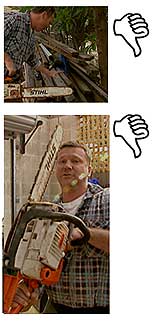As a builder, Scott Cam uses power tools such as chainsaws every day, and he thinks they are fantastic. Although he jokes about ‘toys for the boys’, he actually doesn’t regard power tools as toys. Scott thinks chainsaws are potentially very dangerous, particularly in the hands of untrained and inexperienced operators. Each year hundreds of Australians are injured in both work related and backyard accidents involving chainsaws. One of the most common causes of these accidents is what’s known as kickback. This occurs when the chain or cutting teeth on the chain hits a solid object, such as a nail or a knot in the timber. Because the chain is moving at a very high speed the whole saw is thrown straight back with great force, often striking the operator and causing very serious wounds. Chainsaw teeth produce a ripping effect and cause ragged skin lacerations. Facial injuries, hand and finger injuries, open wounds, fractures and amputations are common.
Scott basically advises against buying and using a chainsaw if there is an alternative way of getting the job done. However, if you are determined to use one, there are some safety issues which must be addressed.
Scott Cam’s Safety Tips
Wear the appropriate safety gear, including earmuffs or ear plugs, hard hat, visor or safety glasses, strong work boots (steel cap preferred), close fitting clothes and leg protection (cut resistant trousers or chaps).
Do not climb ladders or trees with a chainsaw. Tree pruning is best left to a tree surgeon who is a member of a professional arborists’ association.
If you don’t have the training or skills required for a particular job, call in a professional.
Keep a firm grip on the chainsaw with both hands, and maintain a balanced stance.
Don’t ever operate your chainsaw above shoulder height or with your arms stretched out. Holding the chainsaw in awkward positions makes it harder to control and increases the risk of kickback.
The cutting area should be free from obstructions such as junk, bits of pipe or wire. Remove nails from the timber to be cut, set the timber up on stools (sawhorses) and cut each piece individually.
Read the manual thoroughly, and follow the manufacturer’s sharpening and maintenance instructions for your chainsaw.
Attend a chainsaw safety course.
Don’t rush. Be careful, slow down and be safe.



